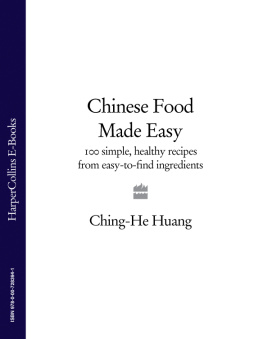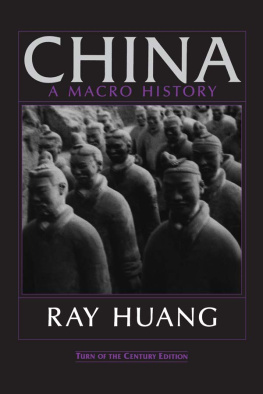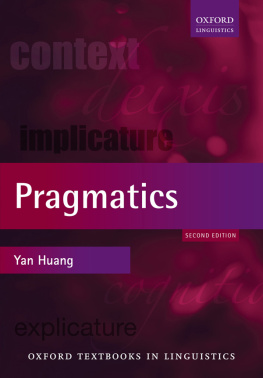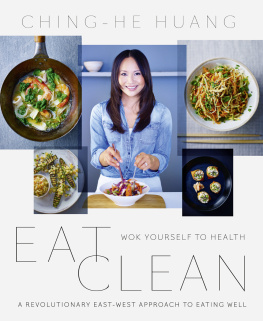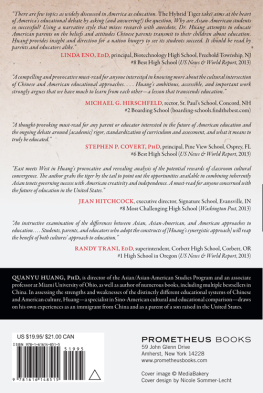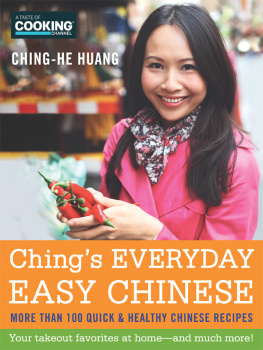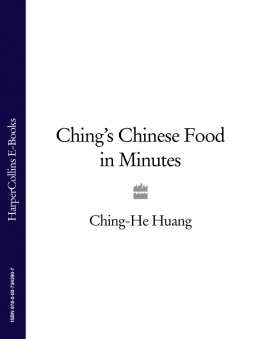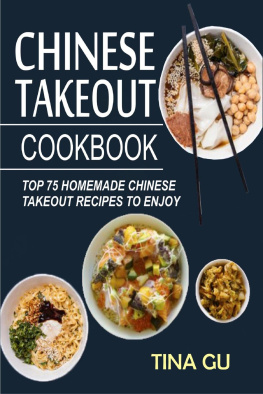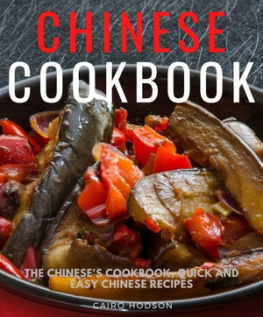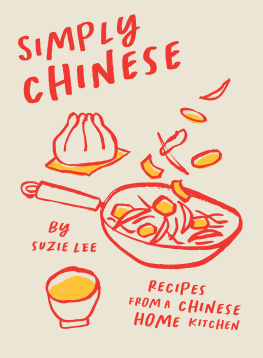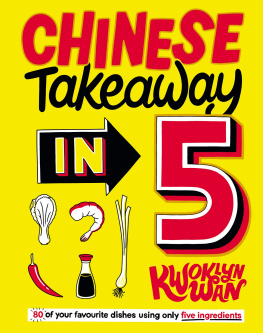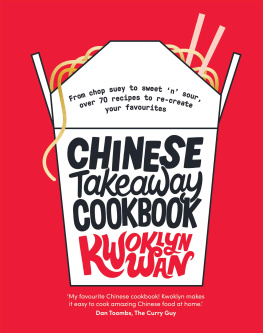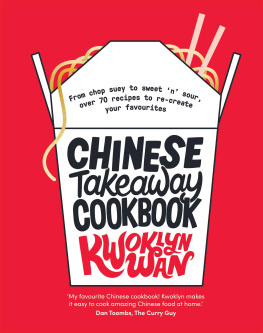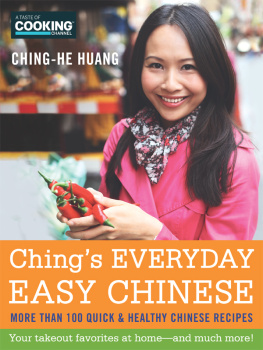Chinese Food Made Easy
Ching-He Huang

Table of Contents
FACT: TRADITIONAL CHINESE COOKING IS HEALTHY
When I first started to forge my TV career, it was difficult to break down the general perception that Chinese cuisine is unhealthy and bad for you. When most people in the UK think about Chinese food they almost always think of the local takeaways, some which are good but many of which are not. Monosodium glutamate (MSG), gloopy sugary sauces, deep-fried dishes laced with fat and salt all dressed up as tasty, but in fact detrimental to ones health. There are over 15,000 Chinese restaurants and takeaways in the UK, and some unfortunately perpetuate this image, but my hope is to dispel this notion and set the record straight.
With their research into thousands of years of Chinese history, historians confirm that Chinese culture derived from its food culture. Chinese are obsessed with food. For centuries, peasants and farmers struggled against famine, poor harvests, and floods. Out of this struggle, cooking techniques such as wok frying were invented, and preserving techniques such as drying, pickling and curing followed. To the Chinese, the genius of all inventions is the wok; the shape of it allows the food to be cooked on a very high heat with very little oil, and with rapid stirring and tossing, the wok cooks the food to perfection. This way of cooking sears the food on the outside, not only helping to create a slight smoky flavour but also retaining the nutrients in the ingredients for optimum health. The wok is also used for steaming (with the help of the bamboo steamer) as well as for braising, smoking and making soups all healthy cooking techniques.
In fact, traditionally, when Chinese families go out to eat at a Chinese restaurant, just one fried dish, or none at all, will accompany the series of dishes ordered to be shared at the table. This was very much the case in my family, when I first grew up with my grandmother. In her kitchen, she would only ever deep-fry food if it was on its last few days of freshness! This method is a safe way of cooking leftover ingredients by heating them in hot oil and therefore killing off any possible bacteria (although if you think of this fact every time you eat fried food, it may just put you off). My grandmother was seriously opposed to ordering fried fish in restaurants it implied the fish was not fresh and she would always insist on having it steamed instead. If the fish was not fresh, it would be overly fishy once cooked, because fresh fish when steamed should be odourless. However, I am not as strict as my grandmother when it comes to cooking or consuming fried foods. Of course, I would hope that all restaurants and takeaways use the freshest ingredients. To ensure that you are eating healthily, my advice is to cook the food yourself; and if you are dining out, then remember that keeping the balance right is key to good health and enjoying any cuisine never too much of one thing is best for you.
In terms of balance, another important aspect of Chinese food is the philosophy of yin and yang this is one of the foundations and principles of Chinese cooking. The belief is that all food has a yin and a yang element attached to it yin foods are cooling and yang foods are heat giving. Traditionally, Chinese cooks would try to balance these foods in any one dish. Yin foods include cucumber, fruits and most vegetables, while yang foods are most meats, ginger, garlic and chillies. So a perfectly balanced dish might have a balance of meat and vegetables. Cooking techniques also impart a yin or yang element to a dish. Stir-frying and steaming are yin, whereas deep-frying is yang so if you deep-fry some vegetables, the dish is balanced overall because the vegetables are yin and deep-frying is yang.
This philosophy not only applies to food in Chinese culture, but also in Feng shui (the practice of creating harmony in the home) and in Traditional Chinese Medicine, with which practitioners, by using certain foods, help heal the body of illnesses caused by imbalances in ones lifestyle. Chinese believe that food is medicine for the body, mind and soul.
MY KIND OF FOOD
With this in mind, I have created dishes in this book that may sound familiar but that have a modern twist in cooking techniques or ingredients. Some of the dishes are new versions of old favourites, and some are traditional recipes I have collected from my travels in China, simplified to demonstrate how healthy, light and simple Chinese cooking can be. Some of these dishes were the result of working with farmers, producers and the British public from all walks of life, who inspired me to re-create recipes that suited their working and home lifestyles Richard, for example, who needed my help to convince the town of Chorley to buy his local, home-grown chillies, and Robbie, who wanted some new healthy recipes to cook for his watch at the Blackburn fire brigade. The recipes are wide ranging, varied and versatile.
From Takeaway Favourites, I love my healthier version of Sweet and sour pork and also my Sweet and tangy chilli beef (which may come as a surprise to many Chinese as it involves eating raw pak choy leaves traditionally, Chinese dont like eating cold raw vegetable dishes. But for health, I think we can take the best of both cultures and create the ideal balance of East and West).
My Spicy Sichuan dishes may surprise but, I hope, also inspire you; these dishes are for chilli lovers try the Spicy hotpot! You can go to town with them and vary the degree of heat to your liking. Many dishes are my simpler takes on the traditional, such as Dan Dan noodles, Sichuan orange beef, Bang-Bang chicken and Spicy warm bacon or lardon and cucumber salad. For vegetarians who love dofu, try my Spicy dofu and edamame beans.
For those who love getting their hands dirty, the Dumplings, Dim Sum and Noodles chapter is for you lots of rolling, folding and stuffing. Try my Wonton noodle soup, Roast pork pastry puffs, Pork and prawn dumplings, or my favourite noodle recipe of all time, Dragon Prawn noodles. These types of dishes are great for a dim sum or cocktail party.
For seafood lovers, check out the Cleansing clam and daikon soup in Fish and Seafood light and delicious, this was one of my grandmothers recipes. Another Huang family favourite is my Mums lobster and mayo brioche, which is not Chinese but so good that I wanted to share it with you! My recipe for Black bean steamed scallops with noodles was inspired by the best seafood in Hong Kong and it wont disappoint. For a great comforting dish, it has to be my Seafood congee if you like seafood risotto then do give this recipe a whirl! To impress, try the Coriander prawns and Longjing tea it is finger-licking good, even if I do say so myself!
For a quick snack explore the Street Food chapter and try my Spiced beef stir-fry topped with spring onion, stuffed in wheat flour tortillas or steamed pancakes, and served with a dollop of wasabi mayo this is a real fusion snack and delicious. Or try the healthy version of my Chicken and vegetable spring rolls.
The Celebration Food chapter has all the dishes I love serving to family and friends. These dishes are more traditional in terms of flavour, such as my Lionhead meatballs, Drunken chicken, Steamed egg, shiitake mushrooms and seaweed, Buddhas stir-fried vegetables and Northern-style bean curd. There are some twists, too try the Steamed sea bass in hot beer and ginger lime sauce and the Lamb chops in dofu ru with adzuki and butter bean mash.
In my family, we usually have fresh citrus fruits after a meal to help cleanse the palate, but I just adore desserts. So I couldnt help but create some light refreshing ones to share with you. Perhaps Durian honey puffs with vanilla ice cream and maple syrup will appeal, or Fruity sticky rice with toffee sauce, Mango madness, Red bean paste and banana spring rolls, Lychee lime and mixed fruit jelly or Empress Dowager Cixis longevity peach pudding might tempt you to get cooking in the kitchen?

